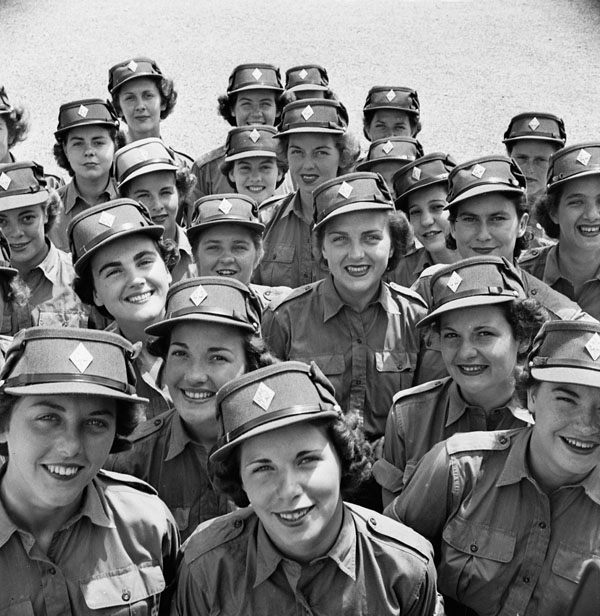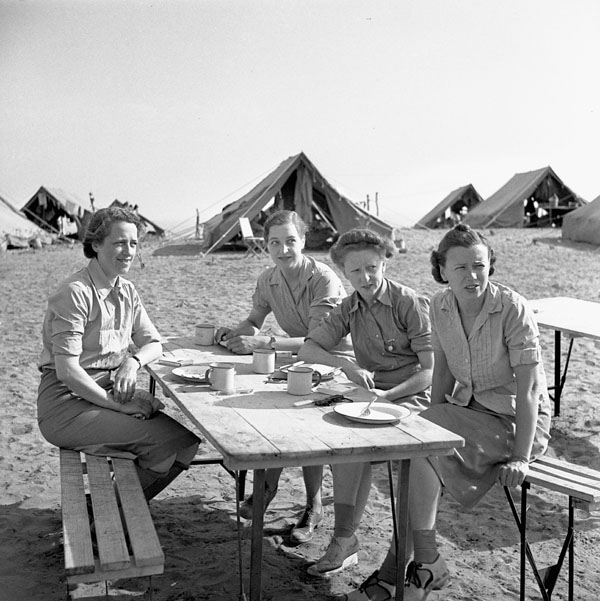Chapter 6. The War Years, 1914–45
6.16 Enlisted Women, Conscription, and the Zombie Army

Mandatory military service was, for King and his contemporaries, the great bogeyman of Canadian affairs. It drove a wedge between French and English Canadians in the First World War and there was no appetite for a repeat of that experience. When asked whether he would introduce conscription, King famously replied “not necessarily conscription but conscription if necessary.” Even the Conservative Leader of the Official Opposition, Robert Manion (1881-1943) was hostile to the idea of conscription. Like Borden in 1914-17, King hoped for a volunteer army. He had luck on his side.
The Depression had two consequences that supported early enlistments. First, people were poor and desperate for a regular paycheque. “Joining up” meant an income and the government paid one’s living costs as well. It also, for a great many, meant dignity, something that was in short supply in the 1930s. In addition, many of the unemployed and working Canadians sympathized and identified with the communists (both those crushed in the Spanish Civil War and the regime in the Kremlin) and/or with the victims of German and Italian invasions in Europe and elsewhere (see Section 7.9). An anti-fascist popular front had formed across communist and social-democratic lines that replaced the pro-Empire sensibilities of August 1914 with something more ideological.
Demand for conscription was strong, however, in English Canadian circles, right from 1939. Its advocates argued that this was a total war and that playing catch-up with troop numbers — as Borden had — was unacceptable. The National Resources Mobilization Act, 1940 (NRMA) passed in June, when the war was not yet a year old and Canadian troops had not yet seen combat, other than those who retreated via Dunkirk a month earlier. The Act allowed Ottawa to register all men eligible for service and to call them up to for home defence if needed. There was plenty of home defence work to be done and these conscripts — contemptuously described by their peers as “zombies” — could attend to that. Support among King’s Quebec MPs was muted but it was a good compromise in that it satisfied some on both sides of the question while not angering any single constituency.
By 1942, however, casualties abroad and in the Battle of the Atlantic meant that numbers needed to be replenished. Arthur Meighen was once again leader of the Conservatives and, unlike his predecessor, Manion, was enthusiastically in support of conscription. King’s strategy was to hold a plebiscite in April asking the electorate to release him from his earlier promise to spare conscripts from service abroad. Although the aggregate returns were 64% in favour of sending zombies abroad, the Quebec numbers were a very decisive 72% against. King now had the instrument in his hands to recruit and mobilize more soldiers but felt powerless to use it.

By 1944, the Canadian armed forces incorporated more than 500,000 fighting men; 21,600 women signed on for the Canadian Women’s Army Corps (CWACs), another 23,000 joined the RCAF (Women’s Division) and the Women’s Royal Canadian Naval Service (WRCNS or, simply and elegantly, the “Wrens”), and nearly 5,000 more served as nursing sisters in the armed forces. King’s insistence that Canadian troops participate in the Italian campaign split the armed services’ command and reduced the likelihood of reinforcements to either the Mediterranean front or Normandy. Both Canadian armies were in some difficulty as a result. By mid-summer in 1944 the question of conscription was back on the table. Reluctantly, in November 1944, King agreed to deploy some of the zombies. Riots broke out in Montreal and Quebec and protests among zombies in camps across British Columbia. The mutiny in Terrace in northwestern BC was the largest military rising, with French-Canadian conscripts joined by English-Canadian zombies.
What saved King’s political career in this instance was the rapidly closing window of war. By the time the conscripts reached Europe the war was all but over.
Key Points
- Voluntarism was made easy by the poor economic conditions in the 1930s and widespread working-class opposition to European fascism.
- Conscription was introduced to beef up the home defence campaign and King’s government promised not to send unwilling conscripts abroad.
- In the midst of the 1944 Italian and Normandy campaigns, King broke his earlier commitment and ordered home defence conscripts — or “zombies” — into active service, producing a rash of protests.
Media Attributions
- Personnel of the Canadian Women’s Army Corps at No. 3 CWAC (Basic) Training Centre © Canada Dept. of National Defence, Library and Archives Canada, (PA-145516) is licensed under a Public Domain license
- Nursing sisters of No. 15 Canadian General Hospital, Royal Canadian Army Medical Corps (R.C.A.M.C.), El Arrouch, Algeria, 15 July 1943 © Lieut. Terry F. Rowe, Canada. Dept. of National Defence, Library and Archives Canada, (PA-213771) is licensed under a Public Domain license
A political alliance of left-wing, progressive parties and organizations to counter fascism in the 1920s, ’30s, and ’40s.
Established in 1941 as a separate non-combatant unit of the Canadian Army; provided support mainly as office staff, drivers/mechanics, and canteen workers; some served overseas.
Formed in 1941 when women from the British Royal Air Force (RAF) arrived in Canada to assist training. Embarrassed, the RCAF agreed to accept women and became the first branch of the armed forces to actively recruit women.
Last of the women’s corps to be established; founded in 1942, it was disbanded in 1946 and reformed as a reserve force during the Korean War.

